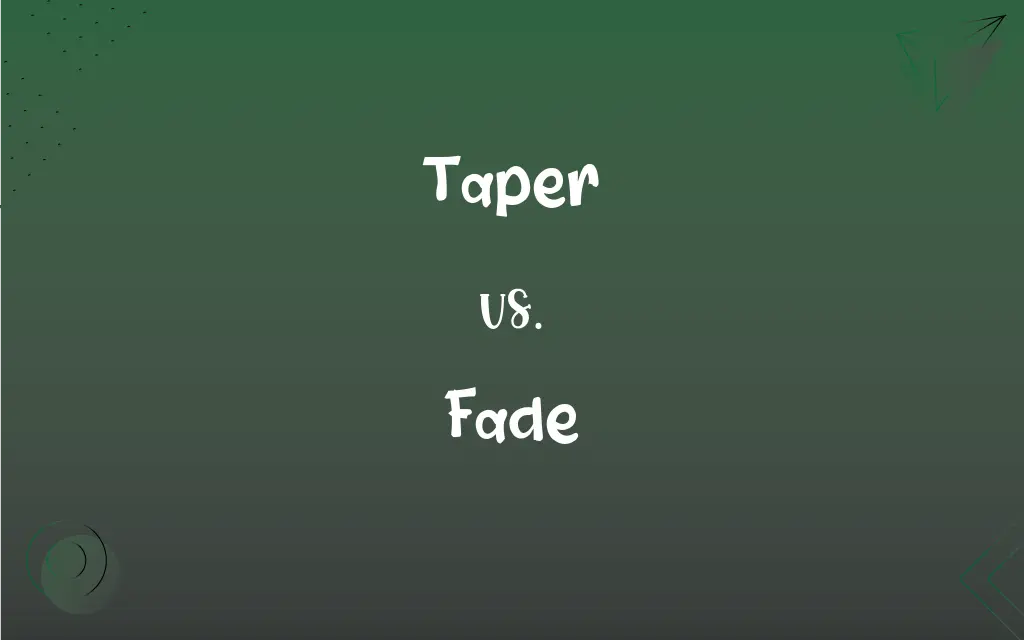Taper vs. Fade: What's the Difference?
Edited by Aimie Carlson || By Harlon Moss || Updated on October 18, 2023
A taper gradually decreases hair length along the sides and back, while a fade is a shorter, more distinct transition, usually ending in skin exposure.

Key Differences
A taper and a fade are both popular haircuts, but they possess distinct characteristics. A taper gradually reduces the length of hair as it moves down the sides and back of the head. This ensures a smooth and subtle transition from long to short hair, maintaining some length even at the nape. In contrast, a fade is a more pronounced style, focusing on showcasing a sharper contrast.
A fade generally involves a much shorter transition, where the hair blends into the skin, particularly at the sides and back. This can be high, mid, or low, depending on where the fade starts. Fades can be dramatic, transitioning from long hair at the top to almost bald at the sides within a short space. On the other hand, tapers maintain more hair, ensuring a softer appearance and transition.
In terms of maintenance, tapers might require less frequent touch-ups compared to fades. Since fades often end in skin exposure, even a small amount of hair regrowth can disrupt the intended look. The taper, with its longer length at the bottom, offers more forgiveness with growth.
Both tapers and fades can be incorporated into various hairstyles, adding structure and flair. While they can be used interchangeably in some contexts, understanding their unique qualities allows for better-informed hair decisions. Their application largely depends on the desired look, the individual's hair type, and personal preference.
Comparison Chart
Transition Length
Gradual and longer
Short and more distinct
ADVERTISEMENT
Ends In
Maintains hair length
Usually skin or very short hair
Maintenance
Less frequent touch-ups
Requires regular upkeep due to sharp contrast
Style Appeal
Subtle and soft
Dramatic and sharp
Versatility
Suited for various hairstyles with softness
Defines structure with pronounced contrast
Taper and Fade Definitions
Taper
To diminish or reduce.
The noise began to taper off as the crowd dispersed.
ADVERTISEMENT
Fade
To lose brightness or vividness over time.
The colors on the flag started to fade after years in the sun.
Taper
A gradual decrease in dimension or strength.
The taper of the cone was perfectly symmetrical.
Fade
To gradually disappear or become less.
Her enthusiasm began to fade as the task became monotonous.
Taper
A slender wax candle.
She lit a taper to illuminate the room.
Fade
A gradual transition from one picture to another in film or TV.
The scene will fade to black before the credits roll.
Taper
To gradually lessen in thickness or width.
The candle begins to taper at the top.
Fade
A hairstyle with short sides and back, transitioning to longer hair on top.
He got a high fade at the barber today.
Taper
A gradual reduction in activity or intensity.
As the year ends, business often sees a taper.
Fade
A decline in strength or importance.
His influence in the industry began to fade.
Taper
A small or very slender candle.
Fade
To lose brightness, loudness, or brilliance gradually
The lights and music faded as we set sail from the harbor.
Taper
A long wax-coated wick used to light candles or gas lamps.
FAQs
Can a fade be long?
Fades typically involve shorter hair, but the length on top can vary, leading to styles like the "long top fade."
What is a taper in haircuts?
A taper is a gradual reduction in hair length down the sides and back of the head.
Is a fade shorter than a taper?
Generally, yes, a fade is shorter and can even expose the skin, while a taper maintains some length.
What products work best for a taper?
Pomades, gels, or creams can be suitable, depending on the hair type and desired look.
Is tapering the same as thinning hair?
No, tapering involves reducing hair length, while thinning reduces hair density.
Why is my fade growing out so quickly?
Since fades often end in very short hair or skin, even slight hair growth can alter the look.
What's a taper fade?
A taper fade combines elements of both, usually featuring a subtle taper that ends in a sharper fade.
How often should I get a taper touched up?
Depending on hair growth and desired look, a taper might need touch-ups every 2-4 weeks.
Do fades suit all head shapes?
The fade's suitability can depend on individual preferences and head shape, but with various types, there's likely a fade that suits most people.
How do I decide between a taper and a fade?
Consider maintenance, desired look, and personal style. Consulting with a barber can also help.
Are fades more modern than tapers?
Both have been popular at different times. While fades have seen a resurgence in recent years, tapers have a timeless appeal.
What's the difference between a high fade and a low fade?
A high fade starts high on the sides and back, while a low fade starts closer to the ears.
Can tapers work with curly hair?
Yes, tapers can be styled with various hair types, including curly hair.
What should I ask my barber if I want a fade?
Specify the type (e.g., high, mid, low) and if you want a skin fade or shadow fade.
Is a taper suitable for professional settings?
Yes, tapers often provide a neat, clean appearance suitable for professional environments.
Are tapers and fades age-specific?
No, both styles can suit individuals of various ages, depending on personal preferences.
Can women have tapered hairstyles?
Absolutely, tapers can be stylish and versatile for both men and women.
Is tapering hair damaging?
When done professionally, tapering should not damage the hair.
How do I maintain my fade between barber visits?
Regular washing, occasional trimming, and using suitable hair products can help maintain a fade.
How do fades look as they grow out?
Fades can lose their sharpness as they grow, potentially necessitating more frequent touch-ups.
About Author
Written by
Harlon MossHarlon is a seasoned quality moderator and accomplished content writer for Difference Wiki. An alumnus of the prestigious University of California, he earned his degree in Computer Science. Leveraging his academic background, Harlon brings a meticulous and informed perspective to his work, ensuring content accuracy and excellence.
Edited by
Aimie CarlsonAimie Carlson, holding a master's degree in English literature, is a fervent English language enthusiast. She lends her writing talents to Difference Wiki, a prominent website that specializes in comparisons, offering readers insightful analyses that both captivate and inform.































































